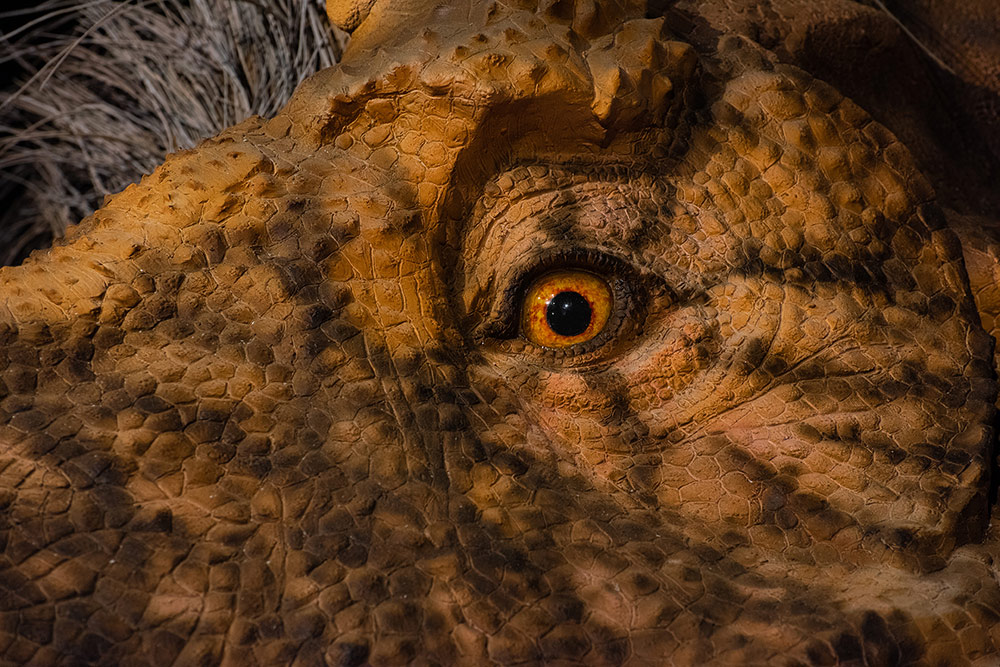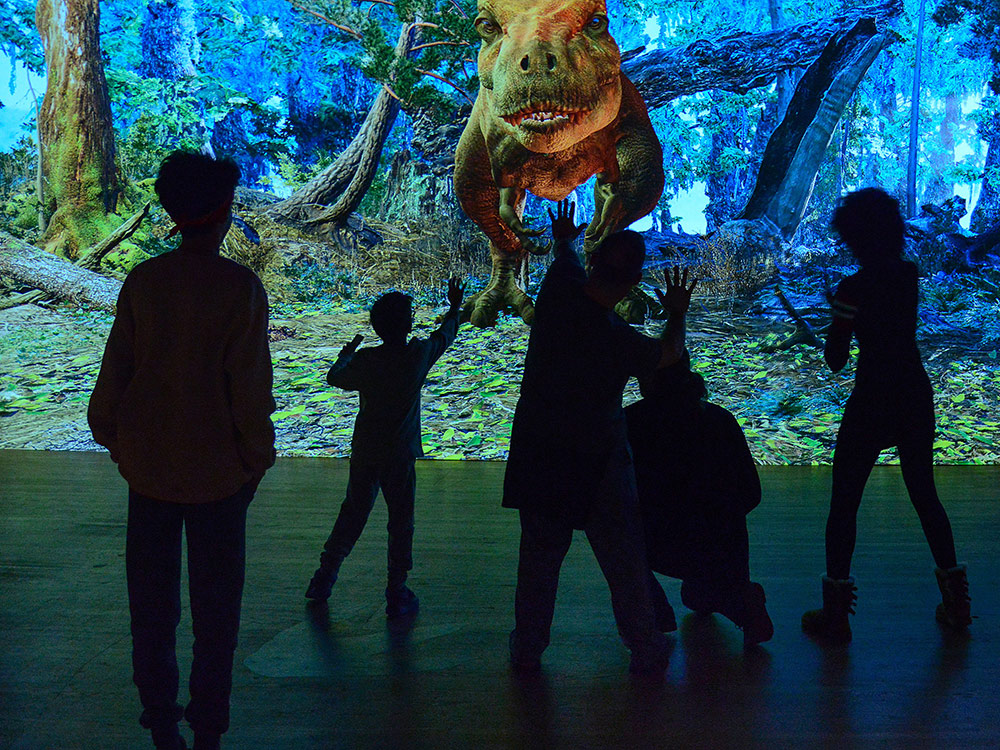How well do you know the Tyrannosaurus rex?
When I attended the recent media preview of T. rex: The Ultimate Predator at Vancouver’s Science World, there were small children virtually clawing at the door of the exhibition, begging to be let in. The show wasn’t yet open to the public, but that didn’t deter these small dinosaur fanatics desperate to see their hero.
If you have any dinosaur fans in your life, bring them to see T. rex, a remarkable collection of new information and very old skeletons of the most famous predator to ever walk the Earth.
I felt for the kids who had to wait to see the show. As a small, easily frightened child, I had an outsized obsession with dinosaurs, spending hours memorizing scientific names, sounding them out in order to get them right. So, although I am a triceratops girl from way back, I can understand the mad desire to see the T. rex in all its majesty.
Even for those who know their dinosaurs, chapter and verse, there are a number of surprises in this exhibition.
One of the most startling of these is the fluffy little pipsqueak that is an infant T. rex. Recent discoveries indicate that baby Ts might have been covered in poufy down feathers. The model that greets visitors at the entrance to the exhibition is a darling little creature, big-eyed and disarming. But this adorable little guy soon morphs into a sullen teenager.
Teen T. rex had long dangly arms, big teeth and was fully covered in feathers. They were capable killing machines, which sounds about right for most teenagers.
And then there is the full-grown version, familiar from stage and screen. But even here, there are a few quirks, like the shaggy feather coif that adorns the predator’s massive head, giving it the look of a lead singer from a heavy metal band.
Like the rock stars of the age, an adult T. rex rarely lived past 28 years of age. The biggest and oldest fossil specimen, affectionately dubbed Scotty, reached age 30.
There is a lot to see and lay hands upon in the show, a density of information that includes everything from the bite strength of the T. rex to the many different dinosaurs that led up to the final culmination in the line. But all the factoids in the world are only the icing on the cake of the pure wonderment on this predatory apotheosis.

What 'Jurassic Park' didn’t tell us
The Jurassic Park films may have spotlighted the dinosaur’s prowess as a hunter, but even they undersold its true potential. The film’s assertion that a T. rex couldn’t see a person if they stood perfectly still is pure poppycock. The T. rex possessed excellent eyesight, with eyeballs the size of oranges, set forward in its skull like a contemporary bird of prey. It also had great depth perception, in addition to a well-developed sense of smell.
If dinosaurs and humans were ever to really cross paths, either strategy of standing still or running away screaming would probably succeed in getting people getting chomped whole. With a bite force of 7,800 pounds, enough to chew through bone, T. rex could turn people into human sashimi with ease.
Although fully grown specimens weren’t particularly fast due to their extreme weight and size, the most they could muster was more akin to a speed walk than a gallop, they were still supreme hunters, but also not above a bit of scavenging as well.
Another persistent notion about the T. rex is that their smallish arms were a vestigial leftover, essentially useless. In fact, their arms were extremely powerful and may have been used to slash prey or help with mating. Let your mind settle on that image for a while. But, as with all things prehistoric, there is considerable debate about this.
Science World does a terrific job of prodding both wild imagining and active questioning. The study of dinosaurs requires both things, as much of what the world looked like 66 million years ago requires a leap of creative thinking.
'To contemplate a dinosaur is to slip from the present'
As the exhibition’s curator Parker McLean explained in the preview, scientists can extrapolate how the T. rex moved by looking at other species that currently inhabit the planet, like emu (their feet resemble that of dinosaurs). But fossilized bones only hint at colour and what other secondary characteristics might have looked like.
One of the vivid manifestations of the T. rex comes from the exhibition’s shadow theatre, wherein projections of the 40-foot skeleton scampers about, in shadow form, providing a sense of the animal’s movement and behaviour. A cast fossil of a T. rex toe bone and thigh bone will also be available for people to get their hands on. On my visit I got to handle a fossilized tooth from T. rex. I’ll admit I was hoping for some prehistoric flashback, a spiritual visitation of sorts from this ancient creature, but it simply felt like a big sharp, serrated rock.
One of the most interesting aspects of paleontology is that it is constantly being revised as new fossils, and even entirely new species are discovered. The T. rex is currently at the centre of science tizzy, with some researchers maintaining that the dinosaur should be split into three separate categories.
This revision has manifested in other, more oblique fashions. The art of painting dinosaurs has moved in step with political and cultural movements of the day.
While early paleo-artists took poetic licence with their depictions of prehistoric life, their creations had lingering impact on the way people think about dinosaurs. Long before Jurassic Park cast the T. rex as the ultimate predator, other artists consistently depicted dinosaurs engaged in acts of brutal ferocity, killing, eating, and then killing some more. The full scope of the animal’s existence was probably much more nuanced, as the Science World exhibit reveals.
Still there is no escape from the blunt wonder of their actual reality. These things really existed in all of their might and majesty. Even seeing their bones returned me to a state of childhood rapture.
Ross Anderson summed up this quality of awe in an Atlantic essay about the beauty of paleo-art: “A dinosaur is a muse, then. To contemplate a dinosaur is to slip from the present, to travel in time, deep into the past, to see the Earth as it was tens, if not hundreds, of millions of years ago, when the continents were nearer, when the forests and oceans teemed with strange plants and creatures. In childhood, the mind is alive to the thrill of that perspective shift.”
Evolutionary timeframes are some deeply strange stuff. It’s hard to wrap your head around the idea that humans are merely a blip on the landscape in comparison to dinosaurs, which clambered all over the planet for 165 to 177 million years. Us puny humans have only been here for about six million.
It’s a reminder that there are other ages than this. And long after we’ve evolved into some other form or been scraped from the planet’s surface entirely, something new will take our place and traipse about for a time before it too changes, and so on and so forth.
But even as evolution’s endless tinkering continues, dinosaurs still rule! Long live the king.
'T. Rex, The Ultimate Predator' is on view until Jan. 22, 2023 at Science World in Vancouver. ![]()
Read more: Science + Tech
















Tyee Commenting Guidelines
Comments that violate guidelines risk being deleted, and violations may result in a temporary or permanent user ban. Maintain the spirit of good conversation to stay in the discussion.
*Please note The Tyee is not a forum for spreading misinformation about COVID-19, denying its existence or minimizing its risk to public health.
Do:
Do not: